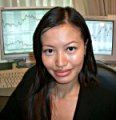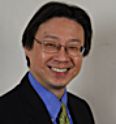
Grace Cheng, founder of www.dailymarkets.com
Lyxor is the ETF provider arm of investment bank Societe Generale. In 2006-2007, they cross-listed some of their ETFs on the Singapore and Hong Kong exchanges. In this interview with DailyMarkets.com, Joseph Ho, Managing Director & Head Of ETF Sales & Marketing In Asia for Lyxor tells us a bit about ETFs from an Asian perspective.
What are the main advantages for an investor in choosing an ETF over a Mutual Fund?
In Asia where tax is not a big issue, ETFs still enjoy many advantages over traditional mutual funds. Amongst them are the usual considerations relating to costs, convenience, transparency and liquidity. In a region where investing through mutual funds still costs 1-3% in front-end commission, the trading costs for ETFs appear insignificant. In 2008, transparency and liquidity were the two reasons many investors decided to venture into ETFs.

Joseph Ho of Lyxor
This was because many investors felt uncomfortable not knowing what assets were held by their mutual funds during fast-changing markets and quite a few funds put up creation/redemption restrictions when investors needed the liquidity the most. As a result, many Asian markets witnessed a rise both in Assets Under Management (AUM) and turnover for ETFs in 2008.
During this economic downturn, a lot of people have been looking for transparency in their investments. Have you seen a growth in your ETF take up rate because of this?
Absolutely. On a global basis, Lyxor saw a net inflow of Euro11.6bn in 2008, almost 3 times the inflow in 2007. In Asia, we also doubled our intake from 2007 with US$160mn despite being a late comer to the region. We cross-listed our first ETF in Singapore in November 2006 and in Hong Kong in April 2007 and did not complete our current product offerings (13 in Singapore and 12 in Hong Kong) until mid-2008.
In stocks, investors look at trading volumes to gauge liquidity. Is volume a significant indicator of liquidity for ETFs?
Yes, volume can be a significant indicator of liquidity of ETFs but not the ONLY indicator. For stocks, trading volume is often the only indicator of liquidity. ETFs are open-ended funds which allow units to be created or redeemed largely reflecting supply & demand. Moreover, market makers are appointed to ensure liquidity in secondary trading for ETFs in Asia even in the absence of buyers or sellers. As such, ETF liquidity can come from the primary creation/redemption process and/or the secondary trading on the exchange.
The true liquidity of an ETF is constrained only by the liquidity of its underlying investments. In dealing with clients, liquidity is often the most misunderstood part about trading ETFs. Many jump to the conclusion that an ETF is illiquid when trading volume is not immediately apparent. Typically, ETFs that invest in overseas markets and those that are benchmarked on less popular or less tradeable indices will inadvertently have smaller trading volume. As long as committed market making support is provided for them, investors should be able to trade them with ease.
Why is a market maker essential to keep ETFs liquid?
Market makers are needed to ensure secondary trading liquidity. The appointment of market makers or liquidity providers to support ETF trading is mandated in most Asian markets. ETFs are often launched privately in relatively small sizes, as low as US$10-20mn. As such, ETFs will not benefit from the Initial Public Offering (”IPO”) process which is common in stock listing - meaning that there would not be an instantaneous pool of investors at listing and no speculative profit expectation from an attractive IPO pricing.
Trading in the early life of an ETF is thus characterized by mostly one-way trades of selling by the market maker to the investors. In this early stage, it is extremely important for the market maker to gain investors’ confidence in the product by providing fair pricing, tight spreads and decent quantities. After a large investor pool is established and the ETF grows in size, strong two-way trading among investors will generate good secondary trading volume. At this point, the role of the market maker will likely diminish.
However, for ETFs that are trading out of time zone, and especially those that are cross-listed, the creation/redemption process and the arbitrage mechanism may not be truly efficient. In these cases, market makers are much more heavily relied upon to provide secondary liquidity by holding inventories and provide tight bid/ask quotes that are close to the ETF’s intraday Net Asset Value (NAV).
What replication strategy does LYXOR use for its ETFs?
Lyxor has been a pioneer in the use of a synthetic replication methodology in the management of its ETFs since 2000. Today, all of over 140 Lyxor ETFs are managed using the same swap-based platform and all are UCITS compliant. The pan-European UCTIS Investment Directive explicitly allows the use of derivatives up to a maximum single counterparty exposure of 10% of any fund’s NAV. This requirement limits the potential losses related to the default of a swap issuer to a maximum of 10%.A swap-based ETF that uses a synthetic replication strategy looks no different from most other fund portfolios.
A Lyxor ETF portfolio will be made up of a basket of stocks accounting for over 90% of the fund’s NAV with the equity-linked swap (”ELS”) accounting for the remainder.The ELS agreement mandates the ELS issuer to pay the ETF 100% of the benchmark performance (net of fees and charges) and receive the performance of the basket of stocks that the ETF holds. It is worth keeping in mind that the ETF retains ownership of the basket of stocks at all times. In the unlikely event that the ELS issuer can no longer honor its obligation to pay for the benchmark performance, the loss in value suffered by the ETF will equal the value of the swap but be limited to a maximum of 10% in the worse scenario.
Nowadays, 60-70% of all ETFs based in Europe employ synthetic replication as they are more cost-effective and can achieve very consistent and low tracking errors regardless of the underlying assets of the ETFs.
Which is LYXOR’s most popular ETF?
In Asia, Lyxor’s most popular ETFs in the last couple of years have been the China Enterprise ETF that tracks the Hang Seng HSCEI (H-shares) , the MSCI All Country Asia ex-Japan ETF and the CRB Commodities ETF.
Joseph Ho is Managing Director, Head of Exchange Traded Funds (ETF) Sales and Marketing, based in Hong Kong. He is responsible for expanding the bank’s ETF business across the Asia-Pacific region including developing new markets and products. Prior to joining, Joseph was with Barclays Global Investors in Hong Kong for 8 years as Regional Director, North Asia and Head of iShares, Asia ex-Japan.
Joseph has over 25 years of experience in the asset management industry in the region, having worked in Hong Kong, Japan and Taiwan. He started his career as a portfolio manager and has since expanded his responsibilities to cover product/business development and marketing & sales.
Recent stories:
GRACE CHENG: What Marc Faber said in HK
ETFs: How to choose them


